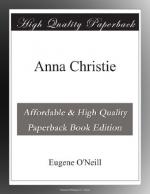|
This section contains 4,836 words (approx. 13 pages at 400 words per page) |

|
John Antush's essay discusses O'Neill's approach to modernism and postmodernism and how his experimentation challenges the form and in the case of Anna Christie 'explodes' the traditional love story.
When we pause to reassess Eugene O'Neill's contribution to American theatre, what astonishes us is not just the sustained dramatic achievement through the period that we now call "modern" (1920-1956 in America), but the multiple ways he anticipates and lays the foundations for a postmodern dramatic aesthetic. O'Neill spent most of his literary career chipping away at those stage conventions that dominated the nineteenth-century theatre and the popular imagination. From his realistic depiction of man's desire to belong to nature in Beyond the Horizon, to his expressionistic portrayal of a possessive god in The Emperor Jones, to the naturalism of operative destiny in Desire Under the Elms, to the surrealistic symbolism of sex in Strange Interlude, to the...
|
This section contains 4,836 words (approx. 13 pages at 400 words per page) |

|




